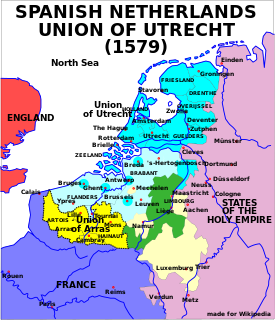
Limburg is the southernmost of the 12 provinces of the Netherlands. The province is bordered by the province of Gelderland to the north and by North Brabant to its west. Its long eastern boundary forms the international border with the state of North Rhine-Westphalia in Germany. To the west is the international border with the similarly named Belgian province of Limburg, part of which is delineated by the river Meuse. The Vaalserberg is on the extreme south-eastern point, marking the tripoint of the Netherlands, Germany and Belgium.

Utrecht is the fourth-largest city and a municipality of the Netherlands, capital and most populous city of the province of Utrecht. It is located in the eastern corner of the Randstad conurbation, in the very centre of mainland Netherlands; it has a population of 361,966 as of 1 December 2021.

The United Provinces of the Netherlands, also known as the (Seven) United Provinces, officially as the Republic of the Seven United Netherlands, and commonly referred to in historiography as the Dutch Republic, was a federal republic which existed from 1588, during the Dutch Revolt, to 1795. It was a predecessor state of the Netherlands and the first fully independent Dutch nation state.

The Union of Utrecht was a treaty signed on 23 January 1579 in Utrecht, Netherlands, unifying the northern provinces of the Netherlands, until then under the control of Habsburg Spain.

The Seventeen Provinces were the Imperial states of the Habsburg Netherlands in the 16th century. They roughly covered the Low Countries, i.e., what is now the Netherlands, Belgium, Luxembourg, and most of the French departments of Nord and Pas-de-Calais (Artois). Also within this area were semi-independent fiefdoms, mainly ecclesiastical ones, such as Liège, Cambrai and Stavelot-Malmedy.

The Old Catholic Church of the Netherlands, sometimes known as the Dutch Roman Catholic Church of the Old Episcopal Order, the Church of Utrecht , or Jansenist Church of Holland, is an Old Catholic jurisdiction originating from the Archdiocese of Utrecht (695–1580). The Old Catholic Church of the Netherlands is the mother church of the Old Catholic Union of Utrecht.

The County of Artois was a historic province of the Kingdom of France, held by the Dukes of Burgundy from 1384 until 1477/82, and a state of the Holy Roman Empire from 1493 until 1659.

Spanish Netherlands was the name for the Habsburg Netherlands ruled by the Spanish branch of the Habsburgs from 1556 to 1714. They were a collection of States of the Holy Roman Empire in the Low Countries held in personal union by the Spanish Crown. This region comprised most of the modern states of Belgium and Luxembourg, as well as parts of northern France, the southern Netherlands, and western Germany with the capital being Brussels. The Army of Flanders was given the task of defending the territory.

The Archdiocese of Utrecht is an archdiocese of the Catholic Church in the Netherlands. The Archbishop of Utrecht is the Metropolitan of the Ecclesiastical province of Utrecht. There are six suffragan dioceses in the province: Breda, Groningen-Leeuwarden, Haarlem-Amsterdam, Roermond, Rotterdam, and 's-Hertogenbosch. The cathedral church of the archdiocese is Saint Catherine Cathedral which replaced the prior cathedral, Saint Martin Cathedral, after it was taken by Protestants in the Reformation.
The Holland Mission or Dutch Mission was the common name of a Catholic Church missionary district in the Low Countries during and after the Protestant Reformation.

The Diocese of Groningen-Leeuwarden is a suffragan Latin diocese of the Catholic Church in the northern part of the ecclesiastical province of the Metropolitan Roman Catholic Archdiocese of Utrecht. It encompasses the provinces of Groningen, Friesland and Drenthe, as well as the Noordoostpolder, a part of the province of Flevoland.

The Roman Catholic Diocese of 's-Hertogenbosch is a diocese of the Catholic church in the Netherlands. The modern diocese was created in 1853. It is a suffragan of the archdiocese of Utrecht. It is currently led by bishop Gerard de Korte. Its see is St John's Cathedral, 's-Hertogenbosch.
Archdiocese of Utrecht or Diocese of Utrecht may refer to:

The Lordship of Groningen was a lordship under the rule of the House of Habsburg between 1536 and 1594, which is the present-day province of Groningen.

The Lordship of Utrecht was formed in 1528 when Charles V of Habsburg conquered the Bishopric of Utrecht, during the Guelders Wars.

The County of Drenthe, was a province of the Holy Roman Empire from 1046, and of the Dutch Republic from 1581 until 1795. It corresponds to the area west of the lower Ems, today the eponymous province of Drenthe in the Netherlands.
The historic diocese of Utrecht (695–1580) was a Roman Catholic diocese and archdiocese in the Low Countries before and during the Protestant Reformation.

On 4 March 1853, Pope Pius IX restored the episcopal hierarchy in the Netherlands with the papal bull Ex qua die arcano, after the Dutch Constitutional Reform of 1848 had made this possible. The re-establishment of the episcopal hierarchy led to the April movement protest in 1853.
The following is a timeline of the history of the municipality of Utrecht, Netherlands.














